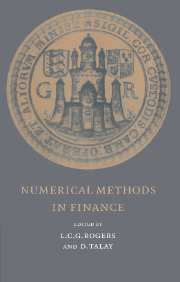Book contents
- Frontmatter
- Contents
- Contributors
- Introduction
- Convergence of Numerical Schemes for Degenerate Parabolic Equations Arising in Finance Theory
- Continuous-Time Monte Carlo Methods and Variance Reduction
- Recent Advances in Numerical Methods for Pricing Derivative Securities
- American Options: A Comparison of Numerical Methods
- Fast, Accurate and Inelegant Valuation of American Options
- Valuation of American Option in a Jump-diffusion Models
- Some Nonlinear Methods for Studying Far-from-the-money Contingent Claims
- Monte Carlo Methods for Stochastic Volatility Models
- Dynamic Optimization for a Mixed Portfolio with Transaction Costs
- Imperfect Markets and Backward Stochastic Differential Equations
- Reflected Backward SDEs and American Options
- Numerical Methods for Backward Stochastic Differential Equations
- Viscosity Solutions and Numerical Schemes for Investment/Consumption Models with Transaction Costs
- Does Volatility Jump or Just Diffuse? A Statistical Approach
- Martingale-Based Hedge Error Control
- The Use of Second-Order Stochastic Dominance To Bound European Call Prices: Theory and Results
Monte Carlo Methods for Stochastic Volatility Models
Published online by Cambridge University Press: 05 June 2012
- Frontmatter
- Contents
- Contributors
- Introduction
- Convergence of Numerical Schemes for Degenerate Parabolic Equations Arising in Finance Theory
- Continuous-Time Monte Carlo Methods and Variance Reduction
- Recent Advances in Numerical Methods for Pricing Derivative Securities
- American Options: A Comparison of Numerical Methods
- Fast, Accurate and Inelegant Valuation of American Options
- Valuation of American Option in a Jump-diffusion Models
- Some Nonlinear Methods for Studying Far-from-the-money Contingent Claims
- Monte Carlo Methods for Stochastic Volatility Models
- Dynamic Optimization for a Mixed Portfolio with Transaction Costs
- Imperfect Markets and Backward Stochastic Differential Equations
- Reflected Backward SDEs and American Options
- Numerical Methods for Backward Stochastic Differential Equations
- Viscosity Solutions and Numerical Schemes for Investment/Consumption Models with Transaction Costs
- Does Volatility Jump or Just Diffuse? A Statistical Approach
- Martingale-Based Hedge Error Control
- The Use of Second-Order Stochastic Dominance To Bound European Call Prices: Theory and Results
Summary
Introduction
The fundamental theorem of valuation by arbitrage reduces the pricing of any European contingent claim to the computation of the expectation of the discounted final reward under some probability measure, equivalent to the initial probability measure, under which the primitive assets processes are martingales. For some simple models and simple contingent claims one can hope to derive a closed form solution of such an expectation as in the seminal work by Black & Scholes (1973). However empirical work pointed out for a long time that such simple models do not fit financial asset price data. Therefore, it is important to develop some computational methods that can handle more complicated models.
Monte Carlo methods appear as a natural tool for such computations since they can deal with models involving many state variables and are well suited for the computation of path-dependent expectations which is the usual case in finance.
In this article, we present an application of Monte Carlo methods for the valuation of contingent claims in stochastic volatility models. In such models the primitive risky asset price process is driven by a bivariate diffusion. Therefore, even for expectations depending only on the terminal value of the process, deterministic methods based on the discretization of the partial differential equation satisfied by the expectation to be computed are timeconsuming. For some path-dependent expectations, deterministic methods can still be used by introducing a new state variable and therefore the dimensionality of the problem is increased (see Barles, Daher & Romano 1990).
- Type
- Chapter
- Information
- Numerical Methods in Finance , pp. 146 - 164Publisher: Cambridge University PressPrint publication year: 1997
- 7
- Cited by



